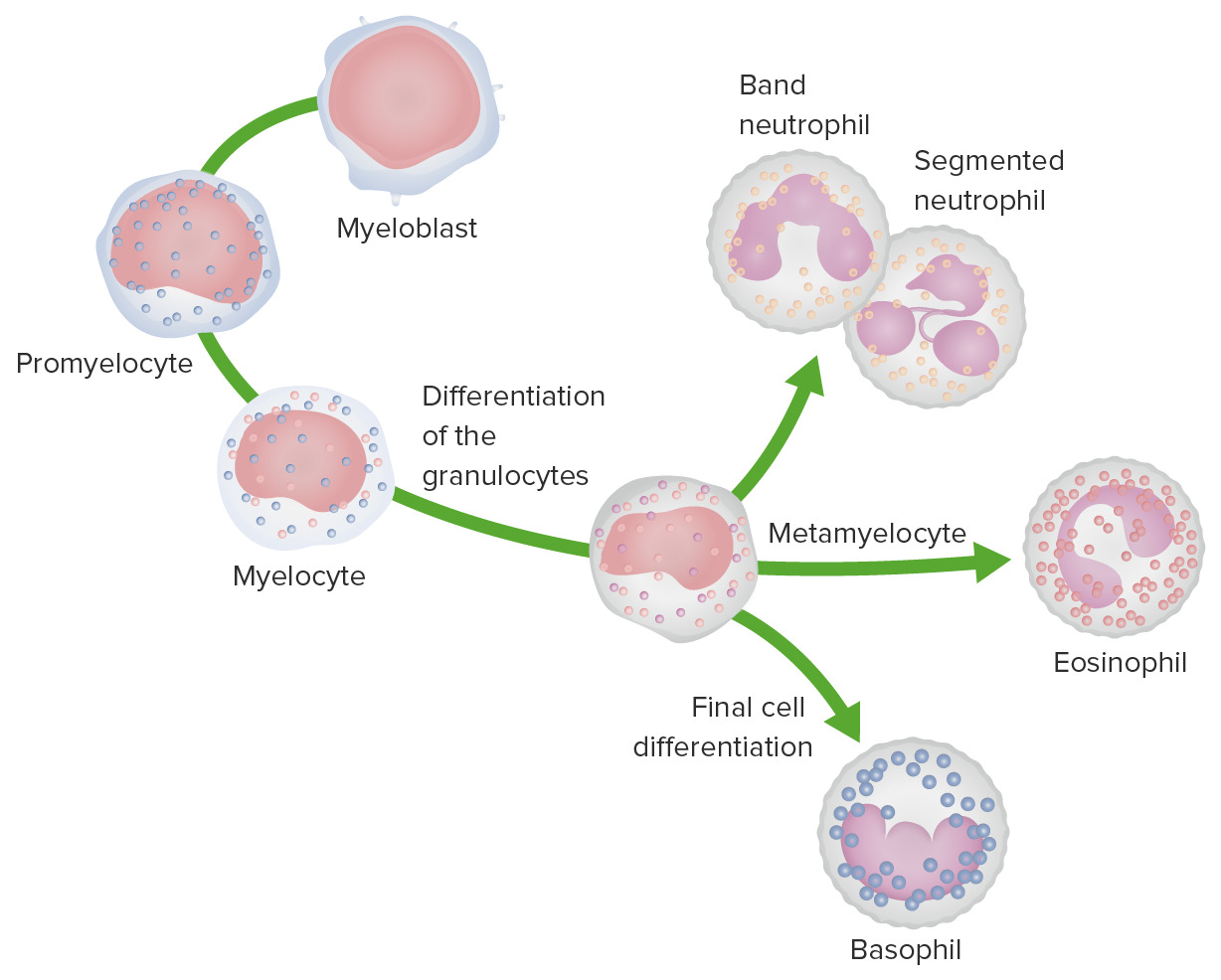Playlist
Show Playlist
Hide Playlist
Stages of Granulopoiesis: Myelocyte
-
Slides 14 Types of Tissues Meyer.pdf
-
Reference List Histology.pdf
-
Download Lecture Overview
00:00 Does it become a neutrophil or a basophil or an eosinophil? The next stage of this cell then passes into is the myelocyte. In those cells, the specific granules will emerge. 00:11 Again those specific granules relate to the different roles of these granulocytes will have. For instance, the specific granule in a neutrophil contains antimicrobial substances or enzymes like collagenase that help digest the microbes in the bacteria that they are going to destroy and then taking to the cell cytoplasm. Whereas the eosinophils and the basophils will have specific granules for their particular role or purpose. 00:52 So these monocytes again are quite large cells and again if you look carefully in the cytoplasm, you see evidence of a granular structure, but you really cannot distinguish what type of granules they are at this early stage. Well the cell then passes into the metamyelocyte stage and the metamyelocyte stage is a very important stage of development because it's at this stage that the cell can no longer divide. Hence a little asterisk I have put next to the term metamyelocyte. But what happens is that the nucleus becomes kidney shaped and sometimes you can see that kidney shaped nucleus when you look at these cells when they are oriented in a way in which they appear when viewed with a light microscope. Sometimes if that cell was rotated around because you are looking at smear of bone marrow, you would not see the kidney shaped nucleus. So it would be difficult in this instance to then identify that cell. But that is one of the characteristic features of the metamyelocyte and let me stress again that this is a stage that the cell can no longer further divide. Well in the case of the neutrophil, that nucleus that was originally a kidney shaped or a bean-shaped then develops further, and we call it a band or a stab cell. Have a look at the nucleus and you see that it is a horseshoe shaped or a U shaped.This is an indication that the cell nucleus is going through this stage or it is actually going to be polymorphonuclear appearance that you see characteristic of the neutrophil. And at the same time that the nucleus is going through differentiation process. Two other things happen. Firstly the granules start become specific for that particular cell type because it is no longer dividing, it is concentrating on being the lineage to which is destined to be. It is concentrating on creating the factory inside the cell within the different granules to fulfill the role of that cell type. In this case, it is a neutrophil. And finally that neutrophil or that nucleus will go through a stage where it becomes as I said before polymorphonuclear or having many forms, many shapes. So, again I hope you have some understanding of the various lineages whereby the myeloblast can give rise to granulocytes. And concentrate again on the actual finished product of the cell types, the neutrophil, the eosinophil and the basophil each has specific granules within them containing different components that serve the role of the cells. So as the cells develop through their lineage, first of all they go through a process of just generally producing granules. And it is only after the metamyelocyte stage when they can no longer divide that the cell then destined to become one of those three types goes through the process of forming the specific contents of those granules. So now I hope you understand a little bit about bone marrow and thank you for listening.
About the Lecture
The lecture Stages of Granulopoiesis: Myelocyte by Geoffrey Meyer, PhD is from the course Bone Marrow.
Included Quiz Questions
Which of the following options shows the correct stages of differentiation into a neutrophil?
- Myeloblast, promyelocyte, myelocyte, metamyelocyte, band cell, segmented neutrophil
- Myeloblast, myelocyte, promyelocyte, metamyelocyte, band cell, segmented neutrophil
- Myelocyte, promyelocyte, metamyelocyte, myeloblast, band cell, segmented neutrophil
- Promyelocyte, metamyelocyte, myelocyte, myeloblast, band cell, segmented neutrophil
- Band cell, myeloblast, promyelocyte, metamyelocyte, myelocyte, segmented neutrophil
Which of the following granulocyte precursors is LEAST capable of mitosis?
- Metamyelocyte
- Committed progenitor cell
- Myeloblast
- Promyelocyte
- Myelocyte
Which of the following are polymorphonuclear cells?
- Neutrophils
- Erythrocytes
- Platelets
- Megakaryocytes
- Lymphocytes
Customer reviews
5,0 of 5 stars
| 5 Stars |
|
1 |
| 4 Stars |
|
0 |
| 3 Stars |
|
0 |
| 2 Stars |
|
0 |
| 1 Star |
|
0 |
very helpful! thanks! Only thing I would add to this are lymphopoiesis and markers for each lineage (Bcells are CD 19,20,21 positive).




